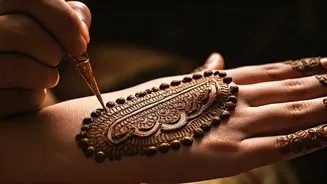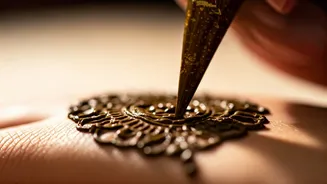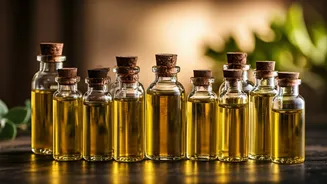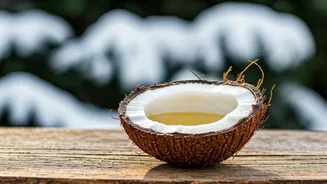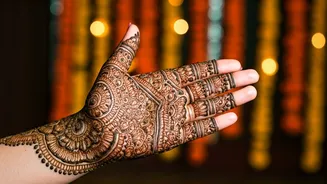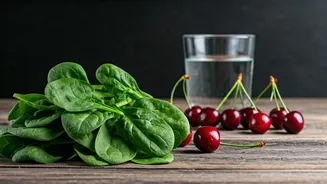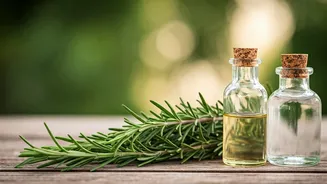Start with Fresh Paste
The foundation for a beautiful mehndi design is always the quality of the henna paste itself. For the richest color and most prolonged stain, it’s imperative
to begin with fresh, high-quality mehndi paste. Freshly prepared paste contains the highest concentration of lawsone, the pigment responsible for the characteristic reddish-brown color. Ensure the paste is made from finely ground henna powder, mixed with the appropriate liquids such as tea or lemon juice, and allowed to sit for the recommended time to release its dye. Using fresh paste ensures that the henna's full potential is realized, leading to a deeper, more vibrant, and longer-lasting stain. Avoid using old or pre-made cones, as their efficacy diminishes over time.
Embrace Natural Oils
Using natural oils, both before and after applying mehndi, significantly influences the final outcome. Applying a thin layer of natural oils like eucalyptus, mustard, or coconut oil before applying the paste helps the henna adhere to the skin. This ensures an even application and prevents the paste from drying out too quickly. After the paste has dried and begins to crack, applying the oil again helps to moisturize the skin and protect the henna design. The oil also prevents the paste from flaking off prematurely, giving it more time to stain the skin effectively. This method helps the lawsone pigment penetrate deeper into the skin, resulting in a richer, darker, and longer-lasting color. It's a simple step with a remarkable impact on the longevity and intensity of the mehndi's color.
Avoid Water for 12 Hours
Protecting your mehndi from water exposure is crucial for the first 12 hours after application. Water can cause the henna paste to lift prematurely, disrupting the staining process and diminishing the color's depth and duration. The lawsone dye needs time to fully bind with the skin, and water can interfere with this chemical reaction. Avoid activities that involve direct water contact, such as washing dishes, showering, or swimming, during this critical period. When washing your hands or engaging in activities where water contact is unavoidable, gently apply a barrier, such as a thin layer of oil or plastic wrap, to shield the mehndi design. The absence of water contact for the initial 12 hours allows the henna to set properly, resulting in a more vivid and enduring stain. This simple measure makes a substantial difference in the final color.
Clove Smoke Magic
Exposing your dried mehndi to clove smoke is an effective technique to deepen and fix the color. After the henna paste has dried completely, carefully hold the design over the smoke of burning cloves. The heat and aromatic compounds in clove smoke are believed to enhance the color, causing the henna stain to appear darker and richer. This process involves a bit of caution, as you want to expose the design to the smoke without burning the skin or the paste itself. The clove smoke seems to help to set the dye and intensify the color as the heat aids the henna's absorption into the skin. This method has been used traditionally and is often recommended for those seeking a deeper, longer-lasting mehndi stain. It is a simple yet impactful way to elevate the final color of your design.
Lemon-Sugar Seal
Creating a lemon and sugar seal on your mehndi design helps to keep the paste moist and allows the dye to set properly. Mix equal parts of lemon juice and sugar and apply the mixture gently over the dried mehndi design. This sticky mixture helps keep the paste in place and prevents it from flaking off before it has fully stained the skin. The lemon juice slightly acidifies the paste, which assists in color development. Apply this mixture gently and sparingly, using a cotton ball or a soft brush, and let it dry naturally. This creates a seal that extends the contact time between the paste and the skin, which in turn leads to a deeper, richer color. Doing this at regular intervals will boost the final result.
Let Time Do Its Work
Allowing the mehndi paste to remain on your skin for as long as possible is a key step in achieving a deep, long-lasting color. The longer the paste stays on the skin, the more time the lawsone pigment has to bind and stain the skin. Aim to keep the paste on for at least 6-12 hours, or even overnight, if possible. Once the paste dries and cracks, protect the design, but let it sit without interference for an extended period to permit the pigment to fully set. The longer the paste is allowed to stay in place, the deeper and richer the stain will ultimately be. This patient step is frequently the most important, yielding a deeper, more profound, and longer-lasting mehndi design, enhancing its beauty.
Gentle Removal of Paste
When it's time to remove the dried mehndi paste, do so with care and patience. Avoid washing the paste off with water, as this can interrupt the staining process and diminish the color. Instead, gently scrape off the paste with a dull edge, such as the back of a butter knife. Another gentle method involves using your hands to gently remove the flaked paste. Once the paste is removed, avoid washing the area with soap or scrubbing it excessively for at least 12 hours. This gives the henna stain time to mature and deepen. After removing the paste, apply a thin layer of natural oil to moisturize the skin and protect the newly revealed design. These careful removal techniques contribute to a more profound, more long-lasting, and richly colored mehndi design.
